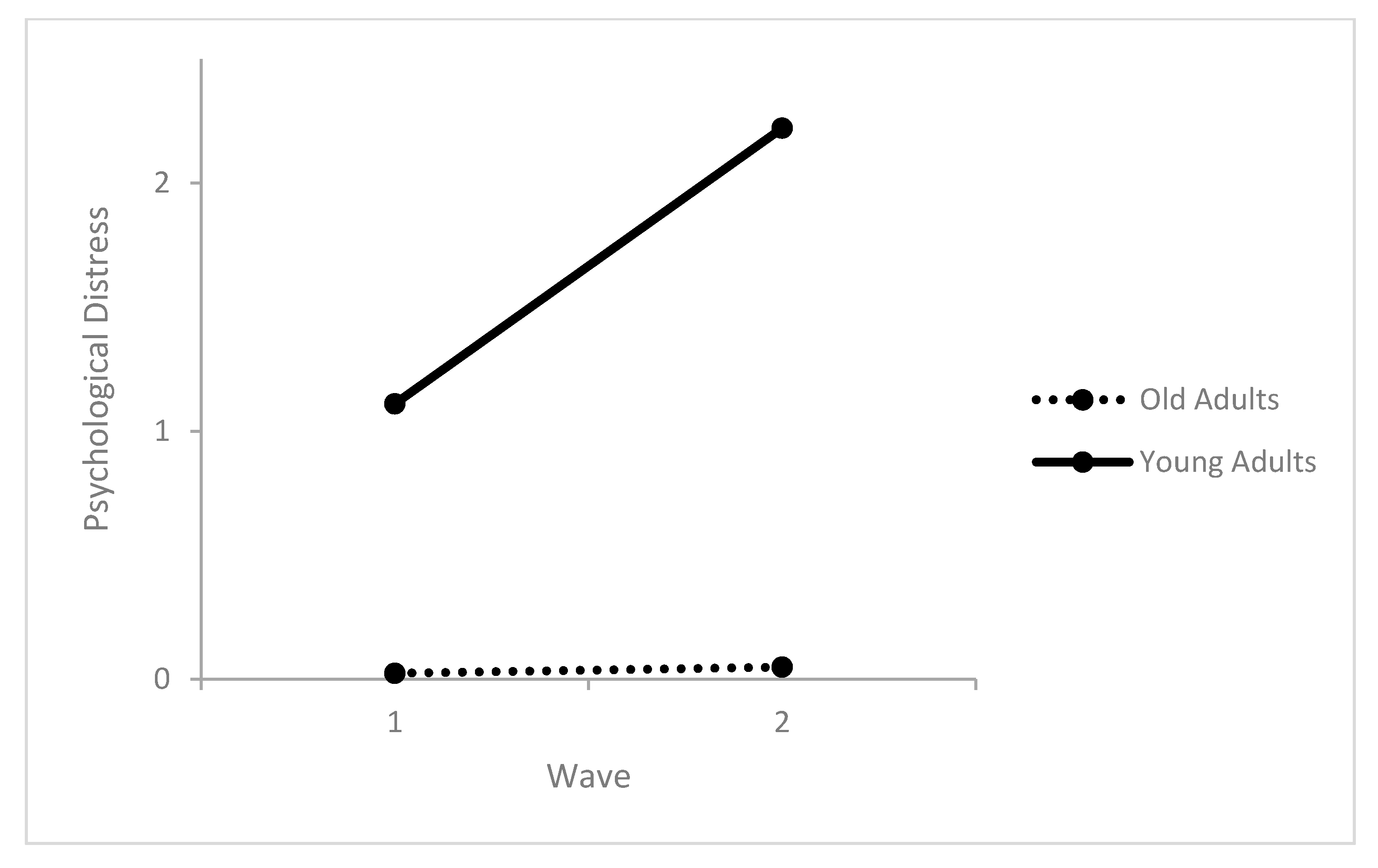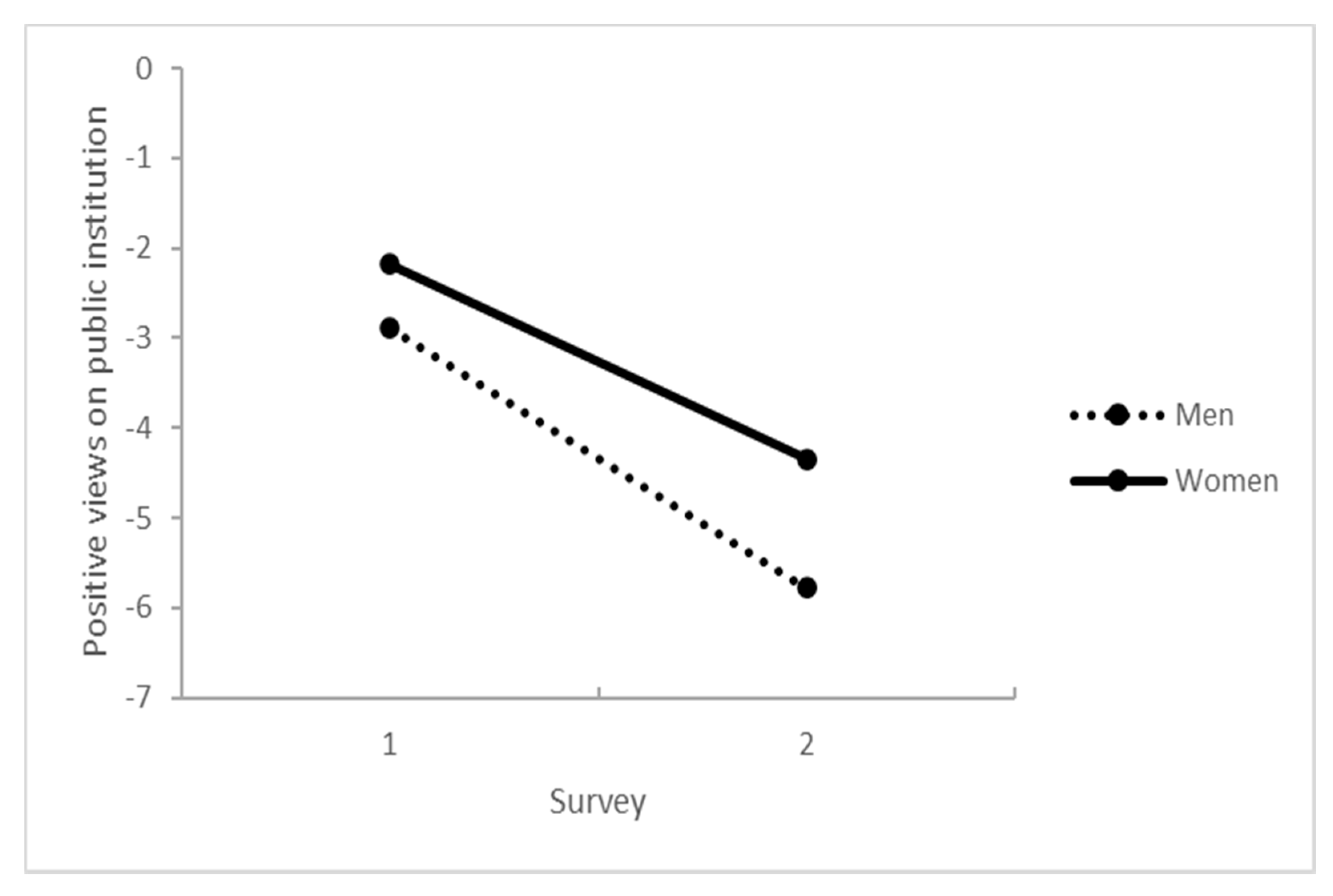Changes in Mental Health and Views on Communication and Activities of Public Institutions among Swedes during the COVID-19 Pandemic—A Cross-Sectional Repeated Measures Design
Abstract
:1. Introduction
- (1)
- Mental health, i.e., life satisfaction, worries, and psychological distress, and views on communication and activities of public institutions have changed among Swedes during the pandemic;
- (2)
- This change is moderated by age and sex;
- (3)
- Changes in the views on communication and activities of public institutions are related to changes in mental health.
2. Materials and Methods
2.1. Study Design
2.2. Participants and Setting
2.3. Measures
2.3.1. Life Satisfaction
2.3.2. Worries
2.3.3. Psychological Distress
2.3.4. The Views on Public Institutions’ Communication and Activities
2.4. Statistical Analysis
3. Results
3.1. Sample Description
3.2. Changes in Mental Health and Views on Communication and Activities of Public Institutions during the Pandemic
Moderation Effects of Age and Sex
3.3. Relation between Changes in Views of Public Institutions’ Activities and Worries in the Surveys
4. Discussion
Limitations and Strengths
5. Conclusions
Author Contributions
Funding
Institutional Review Board Statement
Informed Consent Statement
Data Availability Statement
Acknowledgments
Conflicts of Interest
References
- Adams, S.H.; Park, M.J.; Schaub, J.P.; Brindis, C.D.; Irwin, C.E., Jr. Medical vulnerability of young adults to severe COVID-19 illness-data from the National Health Interview Survey. J. Adolesc. Health 2020, 67, 362–368. [Google Scholar] [CrossRef] [PubMed]
- Sveriges Riksbank. GDP Development in Sweden Relative to the Rest of the World in the Wake of Covid-19. Available online: https://www.riksbank.se/en-gb/press-and-published/notices-and-press-releases/notices/2020/gdp-development-in-sweden-relative-to-other-countries-in-the-wake-of-covid-19/ (accessed on 23 August 2021).
- Abdo, C.; Miranda, E.P.; Santos, C.S.; Júnior, J.B.; Bernardo, W.M. Domestic violence, and substance abuse during COVID19: A systematic review. Indian J. Psychiatry 2020, 62, S337–S342. [Google Scholar] [CrossRef] [PubMed]
- Heras, E.; Garibaldi, P.; Boix, M.; Valero, O.; Castillo, J.; Curbelo, Y.; Gonzalez, E.; Mendoza, O.; Anglada, M.; Miralles, J.C.; et al. COVID-19 mortality risk factors in older people in a long-term care center. Eur. Geriatr. Med. 2021, 12, 601–607. [Google Scholar] [CrossRef] [PubMed]
- Sepulveda-Loyola, W.; Rodríguez-Sánchez, I.; Perez-Rodriguez, P.; Ganz, F.; Torralba, R.; Oliveira, D.; Rodríguez-Mañas, L. Impact of social isolation due to COVID-19 on health in older people: Mental and physical effects and recommendations. J. Nutr. Health 2020, 24, 938–947. [Google Scholar] [CrossRef]
- The Swedes and the Internet. Available online: https://svenskarnaochinternet.se/english/ (accessed on 23 August 2021).
- Aknin, L.; De Neve, J.-E.; Dunn, E.; Fancourt, D.; Goldberg, E.; Helliwell, J.; Jones, S.P.; Karam, E.; Layard, R.; Lyubomirsky, S. Mental health during the first year of the COVID-19 pandemic: A review and recommendations for moving forward. Perspect. Psychol. Sci. 2021. Available online: https://www.hbs.edu/faculty/Pages/item.aspx?num=60280 (accessed on 2 November 2021).
- Pierce, M.; Hope, H.; Ford, T.; Hatch, S.; Hotopf, M.; John, A.; Kontopantelis, E.; Webb, R.; Wessely, S.; McManus, S.; et al. Mental health before and during the COVID-19 pandemic: A longitudinal probability sample survey of the UK population. Lancet Psychiatry 2020, 7, 883–892. [Google Scholar] [CrossRef]
- Robinson, E.; Daly, M. Explaining the rise and fall of psychological distress during the COVID-19 crisis in the United States: Longitudinal evidence from the Understanding America Study. Br. J. Health Psychol. 2021, 26, 570–587. [Google Scholar] [CrossRef]
- Irwin, R.E. Misinformation and de-contextualization: International media reporting on Sweden and COVID-19. Global Health 2020, 13, 62. [Google Scholar] [CrossRef] [PubMed]
- Kavaliunas, A.; Ocaya, P.; Mumper, J.; Lindfeldt, I.; Kyhlstedt, M. Swedish policy analysis for Covid-19. Health Policy Technol. 2020, 9, 598–612. [Google Scholar] [CrossRef] [PubMed]
- Harring, N.; Jagers, S.C.; Löfgren, Å. COVID-19: Large-scale collective action, government intervention, and the importance of trust. World Dev. 2021, 138, 105236. [Google Scholar] [CrossRef] [PubMed]
- Klein, D.B.; Book, J.; Bjørnskov, C. Possible Factors for Sweden’s High Covid Death Rate among the Nordics. Available online: https://papers.ssrn.com/sol3/papers.cfm?abstract_id=3674138 (accessed on 23 August 2021).
- Park, C.L.; Russell, B.S.; Fendrich, M.; Finkelstein-Fox, L.; Hutchison, M.; Becker, J. Americans’ COVID-19 stress, coping, and adherence to CDC guidelines. J. Gen. Intern. Med. 2020, 35, 2296–2303. [Google Scholar] [CrossRef]
- González-Sanguino, C.; Ausín, B.; ÁngelCastellanos, M.; Saiz, J.; López-Gómez, A.; Ugidos, C.; Muñoz, M. Mental health consequences during the initial stage of the 2020 coronavirus pandemic (COVID-19) in Spain. Brain Behav. Immun. Health 2020, 87, 172–176. [Google Scholar] [CrossRef] [PubMed]
- Lieberoth, A.; Lin, S.Y.; Stöckli, S.; Han, H.; Kowal, M.; Gelpi, R.; Chrona, S.; Tran, T.P.; Jeftić, A.; Rasmussen, J.; et al. Stress and worry in the 2020 coronavirus pandemic: Relationships to trust and compliance with preventive surveys across 48 countries in the COVIDiSTRESS global survey. R. Soc. Open Sci. 2021, 8, 200589. [Google Scholar] [CrossRef] [PubMed]
- Vindegaard, N.; Benros, M.E. COVID-19 pandemic and mental health consequences: Systematic review of the current evidence. Brain Behav. Immun. Health 2020, 89, 531–542. [Google Scholar] [CrossRef] [PubMed]
- Xiong, J.; Lipsitz, O.; Nasri, F.; Lui, L.M.W.; Gill, H.; Phan, L.; Chen-Li, D.; Iacobucci, M.; Ho, R.; Majeed, A.; et al. Impact of COVID-19 pandemic on mental health in the general population: A systematic review. J. Affect. Disord. 2020, 277, 55–64. [Google Scholar] [CrossRef] [PubMed]
- Pieh, C.; Budimir, S.; Delgadillo, J.; Barkham, M.; Fontaine, J.R.J.; Probst, T. Mental health during COVID-19 lockdown in the United Kingdom. Psychosom. Med. 2021, 83, 328–337. [Google Scholar] [CrossRef]
- Blix, I.; Birkeland, M.S.; Thoresen, S. Worry and mental health in the Covid-19 pandemic: Vulnerability factors in the general Norwegian population. BMC Public Health 2020, 21, 928. [Google Scholar]
- Haerpfer, C.; Inglehart, R.; Moreno, A.; Welzel, C.; Kizilova, K.; Diez-Medrano, J.; Lagos, M.; Norris, P.; Ponarin, E.; Puranen, B.; et al. (Eds.) World Values Survey: Round Seven-Country-Pooled Datafile; JD Systems Institute & WVSA Secretariat: Madrid, Spain; Vienna, Austria, 2020. [Google Scholar] [CrossRef]
- World Medical Association Declaration of Helsinki Ethical Principles for Medical Research Involving Human Subjects; World Medical Association: Washington, DC, USA, 2002.
- Vetenskapsrådet. Good Research Practice; Swedish Research Council: Stockholm, Sweden, 2017. [Google Scholar]
- Holmbeck, G.N. Toward terminological, conceptual, and statistical clarity in the study of mediators and moderators: Examples from the child-clinical and pediatric psychology literatures. J. Consult. Clin. Psychol. 1997, 65, 599–610. [Google Scholar] [CrossRef]
- Esaiasson, P.; Sohlberg, J.; Ghersetti, M.; Johansson, B. How the coronavirus crisis affects citizen trust in institutions and in unknown others: Evidence from ‘the Swedish experiment’. Eur. J. Polit. Res. 2021, 60, 748–760. [Google Scholar] [CrossRef]
- Sønderskov, K.M.; Daugbjerg, C. The state and consumer confidence in eco-labeling: Organic labeling in Denmark, Sweden, The United Kingdom and The United States. J. Agric. Human Values 2011, 28, 507–517. [Google Scholar] [CrossRef] [Green Version]
- Kittel, B.; Kalleitner, F.; Schiestl, D.W. Avoiding a public health dilemma: Social norms and trust facilitate preventive behaviour if individuals perceive low COVID-19 health risks. 2021, 4, 1–38. [Google Scholar] [CrossRef]
- Thomas, E. Coronavirus: Impact on Young People with Mental Health Needs. Available online: https://www.youngminds.org.uk/about-us/reports-and-impact/coronavirus-impact-on-young-people-with-mental-health-needs (accessed on 23 August 2021).
- Settersten, R.A., Jr.; Bernardi, L.; Härkönen, J.; Antonucci, T.C.; Dykstra, P.A.; Heckhausen, J.; Kuh, D.; Mayer, K.U.; Moen, P.; Mortimer, J.T. Understanding the effects of Covid-19 through a life course lens. Adv. Life Course Res. 2020, 45, 1–11. [Google Scholar] [CrossRef]



| Total N = 4458 | Survey 1 N = 2554 | Survey 2 N = 1904 | p-Value between Surveys | |
|---|---|---|---|---|
| Age mean (SD) | 51.2 (16.9) | 49.3 (17.1) | 52.44 (16.6) | <0.001 |
| Sex n (%) | ||||
| Men Women | 2118 (47.5) 2340 (52.5) | 1225 (48.0) 1329 (52.0) | 893 (46.9) 1011 (53.1) | 0.999 |
| Highest education n (%) | ||||
| Compulsory school (9 years) Senior high school University Other | 237 (5.3) 1751 (39.3) 2461 (55.2) 9 (0.2) | 139 (5.4) 1013 (39.7) 1396 (54.7) 6 (0.2) | 98 (5.1) 738 (38.8) 1065 (55.9) 3 (0.2) | 0.406 |
| Occupation n (%) | ||||
| Students Manual workers Non-manual workers Self-employed Parental leave Sick leave/early retired Retired Unemployed Other | 395 (8.9) 1019 (22.9) 1547 (34.7) 269 (6.0) 53 (1.2) 119 (2.7) 928 (20.8) 73 (1.6) 55 (1.2) | 254 (9.9) 597 (23.4) 872 (34.1) 151 (5.9) 35 (1.4) 68 (2.7) 504 (19.7) 44 (1.7) 29 (1.1) | 141 (7.4) 422 (22.2) 675 (35.5) 118 (6.2) 18 (0.9) 51 (2.7) 424 (22.3) 29 (1.5) 26 (1.4) | 0.012 |
| Cohabitation status n (%) | ||||
| Living with partner | 3041 (68.4) | 1729 (67.7) | 1312 (69.0) | 0.174 |
| Origin n (%) | ||||
| Born in Sweden Mother born in Sweden Father born in Sweden | 4105 (94.2) 3963 (91.0) 3785 (86.9) | 2347 (94.4) 2269 (91.2) 2164 (87.0) | 1758 (94.1) 1694 (90.6) 1621 (86.7) | 0.927 |
| Housing n (%) | ||||
| Tenancy Condominium Villa Other | 991 (22.2) 991 (22.2) 2345 (52.6) 131 (2.9) | 583 (22.8) 566 (22.2) 1328 (52.0) 77 (3.0) | 408 (21.4) 425 (22.3) 1017 (53.4) 54 (2.8) | 0.344 |
| Children | ||||
| Living at home n (%) | 1602 (35.9) | 942 (36.9) | 660 (34.7) | 0.199 |
| Dependent Variables | ||||
|---|---|---|---|---|
| Independent Variables | Life Satisfaction t (4392) = 1.903 p > 0.05 | Worries t (4392) = 4.375 *** | Psychological Distress t (4392) = 0.920, p > 0.05 | View on Public Communication and Activities t (4286) = 17.418 *** |
| M (SD) | M (SD) | M (SD) | M (SD) | |
| Survey 1 | 36.253 (8.373) | 10.298 (2.245) | 7.151 (2.924) | 21.785 (4.577) |
| Survey 2 | 35.758 (8.674) | 10.603 (2.281) | 7.236 (3.137) | 19.266 (4.806) |
| Dependent Variables | ||||
|---|---|---|---|---|
| Independent Variables | Life Satisfaction F (5; 4388) = 45.103 *** | Worries F (5; 4326) = 46.286 *** | Psychological Distress F (5; 4388) = 22.567 *** | View on Public Communication and Activities F (5; 4282) = 159.671 *** |
| β | β | β | β | |
| Survey | −0.008 | 0.145 ** | −0.010 | −0.363 *** |
| Sex | 0.049 | 0.265 *** | 0.056 | 0.163 ** |
| Age | 0.182 *** | 0.118 *** | 0.060 | 0.099 * |
| Survey*sex | −0.091 | −0.100 | 0.070 | 0.142 * |
| Survey*age | 0.041 | −0.093 * | −0.180 *** | 0.058 |
Publisher’s Note: MDPI stays neutral with regard to jurisdictional claims in published maps and institutional affiliations. |
© 2021 by the authors. Licensee MDPI, Basel, Switzerland. This article is an open access article distributed under the terms and conditions of the Creative Commons Attribution (CC BY) license (https://creativecommons.org/licenses/by/4.0/).
Share and Cite
Kerstis, B.; Giannotta, F.; Wågert, P.v.H.; Hellström, C.; Lindberg, D.; Stier, J.; Elvén, M. Changes in Mental Health and Views on Communication and Activities of Public Institutions among Swedes during the COVID-19 Pandemic—A Cross-Sectional Repeated Measures Design. Healthcare 2021, 9, 1498. https://doi.org/10.3390/healthcare9111498
Kerstis B, Giannotta F, Wågert PvH, Hellström C, Lindberg D, Stier J, Elvén M. Changes in Mental Health and Views on Communication and Activities of Public Institutions among Swedes during the COVID-19 Pandemic—A Cross-Sectional Repeated Measures Design. Healthcare. 2021; 9(11):1498. https://doi.org/10.3390/healthcare9111498
Chicago/Turabian StyleKerstis, Birgitta, Fabrizia Giannotta, Petra von Heideken Wågert, Charlotta Hellström, Daniel Lindberg, Jonas Stier, and Maria Elvén. 2021. "Changes in Mental Health and Views on Communication and Activities of Public Institutions among Swedes during the COVID-19 Pandemic—A Cross-Sectional Repeated Measures Design" Healthcare 9, no. 11: 1498. https://doi.org/10.3390/healthcare9111498
APA StyleKerstis, B., Giannotta, F., Wågert, P. v. H., Hellström, C., Lindberg, D., Stier, J., & Elvén, M. (2021). Changes in Mental Health and Views on Communication and Activities of Public Institutions among Swedes during the COVID-19 Pandemic—A Cross-Sectional Repeated Measures Design. Healthcare, 9(11), 1498. https://doi.org/10.3390/healthcare9111498







